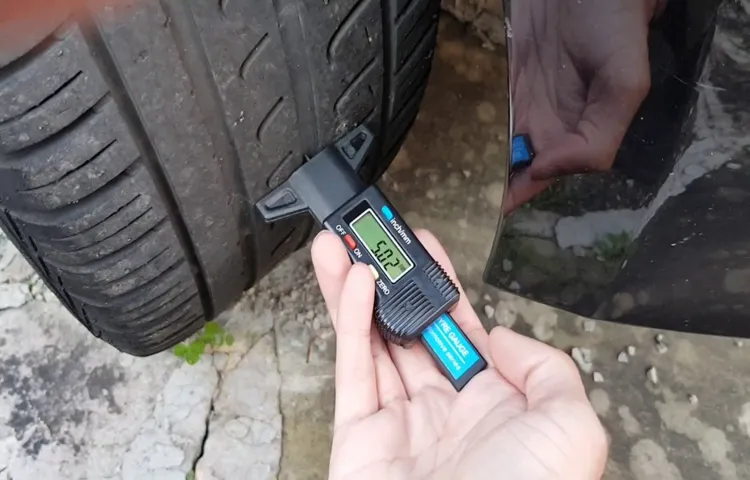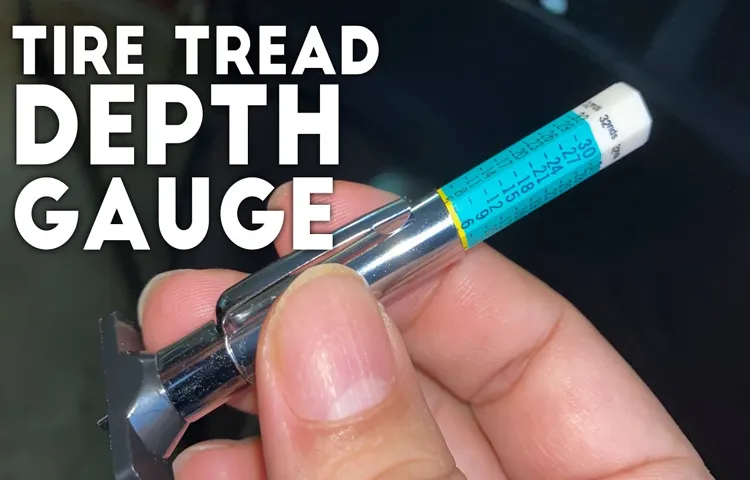Have you ever wondered how to use a tire depth gauge? Checking the depth of your tires might seem like a confusing task, but with a simple tool and a bit of practice, anyone can do it. Keeping track of your tire depth is crucial for your safety on the road, as tires with low tread depth can cause skidding and hydroplaning on wet surfaces. In this blog post, we will guide you through the process of using a tire depth gauge, step by step.
Whether you are a seasoned driver or a new one, this guide will help you understand the importance of tire depth and how to keep your vehicle safe on the road. So let’s dive in and explore how to use a tire depth gauge.
Table of Contents
What is a Tire Depth Gauge?
Using a tire depth gauge is a simple but important task that every driver should know how to do. Essentially, a tire depth gauge is a tool used to measure the tread depth on your vehicle’s tires. This is important because the depth of the tread affects your car’s handling and performance, particularly on wet or slippery roads.
To use the gauge, simply press the tool into the tread grooves, making sure it’s straight and level, and then read the results from the gauge’s display. It’s important to check your tire’s tread depth regularly and replace your tires if the depth falls below the recommended level for your vehicle. By doing so, you’ll ensure that your car remains safe and reliable on the road.
So, don’t hesitate to invest in a tire depth gauge and to learn how to use it properly.
Explanation of tire depth gauge and its importance
A tire depth gauge is a small tool used to measure the depth of the grooves on the surface of your tire. This tool is important because it can help you determine if your tires need to be replaced. When a tire’s tread depth gets too low, it can affect how well your car handles on the road and can decrease your ability to stop quickly in an emergency.
Many depth gauges will be able to measure the depth of your tire’s grooves in both millimeters and 32nds of an inch. It’s recommended to check your tire’s depth at least once a month or before any long road trips. Using a tire depth gauge is easy, simply insert the probe end into the groove and read the results on the gauge.
It’s important to keep your tires in good condition to ensure your safety while driving, so don’t forget to check their depth with a tire depth gauge regularly.

Steps for Using a Tire Depth Gauge
If you’re wondering how to use a tire depth gauge, the process is simpler than you might think. First of all, ensure that your tire is cool to the touch as the gauge will give you a more accurate reading. Next, locate the tread groove – this is the area between the individual tread blocks on your tire.
Then, insert the gauge into a groove and press it against the bottom of the groove until you feel resistance. Read the gauge and note the depth measurement. Repeat in multiple locations around the tire and take the lowest measurement as your official tread depth.
With this information, you’ll be able to determine whether your tires need replacing or if you can safely continue using them. Remember, proper tire maintenance is crucial for the safety of you and your passengers, so be sure to check your tire depth regularly with a reliable gauge.
Step 1: Locate the Tread Wear Indicator
As a responsible car owner, it’s essential to keep an eye on your tire’s tread depth. Not only does it help improve your vehicle’s handling and performance, but it also ensures your safety on the road. Using a tire depth gauge is an easy way to check your tire’s tread depth accurately.
The first step is to locate the tread wear indicator, which is usually marked by a triangular or square rubber bar between the tire’s grooves. This indicator denotes the minimum depth of your tire’s tread, so if it’s level with the surrounding rubber, it’s time to replace your tires. Once you’ve found the tread wear indicator, place the tip of your tire depth gauge in the groove beside it, and press down until you reach the base of the groove.
The gauge will give you an accurate reading of the depth, and you can repeat this process in several locations on each tire. Using a tire depth gauge is quick, simple, and essential for your safety on the road.
Step 2: Insert the Gauge into the Tire Tread
Using a tire depth gauge properly is crucial for checking the tread on your car tires. Step two involves inserting the gauge into the tire tread. This is a simple process that requires placing the probe of the gauge perpendicular to the tire tread.
The flat base of the gauge should rest on the top of the tread, while the probe slides into the grooves of the tire. It’s important to make sure the gauge is straight and not at an angle, as this will affect the readings. Gently apply pressure to the base of the gauge to ensure a close contact with the tire tread.
Once the gauge is in place, take note of the measurement displayed on the gauge. This measurement will help determine the overall health of your tires, as well as when it’s time to replace them. By using a tire depth gauge properly, you can ensure your tires are in good condition and enhance your driving safety.
Step 3: Read and Record the Measurement
Using a tire depth gauge requires a few easy steps, and it’s essential to ensure that you have accurate measurements to get an accurate analysis of your tire’s condition. To start, insert the probe’s pointed end into the tire’s grooves, making sure to push it all the way down. After that, look for the measurement on the device’s gauge or digital display.
Once you have taken the measurement, record it for future reference. It’s essential to take readings in various spots on the tire, as the wear may not be uniform. For example, if you take measurements on the outer edges of the tire, you may notice that the depth is much different than in the center.
Therefore, it’s best to take measurements at various spots to get a more accurate analysis of the tire’s condition. With these steps, you can quickly and accurately use a tire depth gauge to determine whether your tire is safe for the road or needs to be replaced.
Interpreting Tire Depth Gauge Readings
Have you ever wondered how to use a tire depth gauge? Tire tread depth plays a crucial role in the safety and performance of your vehicle. Using a tire depth gauge can help you accurately measure the depth of your tread, which allows you to determine if a tire needs to be replaced. It’s important to note that the minimum legal tread depth requirement is 2/32 of an inch – anything less than this can result in decreased traction and an increased risk of hydroplaning.
To use a tire depth gauge, simply press the gauge into the center of the tire’s tread and read the measurement displayed on the gauge. Repeat this process in various areas around the tire for an accurate overall measurement. Regularly checking your tire tread depth can help you avoid potential hazards and ensure that your vehicle is operating at its safest and most efficient level.
How to know if your tire is safe to use?
Tire Depth Gauge Readings Tires are one of the most essential parts of any vehicle and their maintenance cannot be stressed enough. It is imperative to check the tire depth gauge readings from time to time to ensure that your tires are safe to use. The proper tire depth and inflation are vital to ensure maximum tire performance, longevity, safety, and proper traction on the road.
A depth gauge can give you an accurate measurement of your tire’s tread depth, indicating how much rubber is left on the tire’s surface. A tire depth of 2/32 inch is considered illegal and dangerous as it can lead to poor traction and hydroplaning on wet roads. In addition, if the tread on your tire is wearing unevenly, it might be time to get them checked by a certified mechanic.
Your tires are your vehicle’s direct contact point to the road, so ensuring they are in good condition is crucial for your safety and the safety of others on the road.
When to replace your tires?
When it comes to tire safety, there are few things more important than knowing when it’s time to replace them. One of the simplest ways to determine this is by using a tire depth gauge. This handy tool measures the depth of the tire’s tread, which is important because it directly affects grip on the road.
If your tires have a tread depth of less than 2/32 of an inch, it’s time to replace them. Another important aspect to consider is the wear pattern of the tires. Uneven wear can indicate wheel misalignment or other issues that can affect safety.
Even if the tread depth is still acceptable, tires with serious wear patterns should be replaced. Regularly checking the depth gauge and wear patterns of your tires can help ensure your safety on the road.
Final Thoughts and Cautionary Tips
In conclusion, using a tire depth gauge is not difficult, but it requires a certain level of knowledge and attentiveness. The tool’s accurate readings give an insight into tire wear, ensuring safe driving conditions. However, it’s essential to take caution when measuring, ensuring proper placement, and to avoid pushing too hard, which can harm the tire and affect the readings.
It’s good practice to measure tires regularly and keep a record of them to notice any abnormalities or significant changes. Remember, your tires are crucial to your vehicle’s safety, and taking care of them is an investment in your and your passengers’ well-being. By following the recommended guidelines and staying vigilant, you can ensure your tires remain in top condition, giving you peace of mind on the road.
So, next time you’re checking your tire depths, keep these tips in mind, and remember to stay safe.
Conclusion
In the world of driving, safety always comes first. And when it comes to ensuring your vehicle’s safety on the road, tire maintenance is not to be overlooked. That’s where the tire depth gauge comes into play.
Not only is it easy to use, but it’s also a simple tool that can help you identify potential risks on the road. By keeping your tire treads at a safe level, you’re not only protecting yourself and your passengers, but you’re also prolonging the life of your tires. So, remember to keep a tire depth gauge handy and measure your tire treads regularly.
Because as the old saying goes – better safe than sorry, and in this case, better witty than flat!”
FAQs
What is a tire depth gauge and why do I need one?
A tire depth gauge is a tool used to measure the depth of tire tread. It is important to regularly check your tire tread depth as it affects your vehicle’s safety and performance on the road.
How do I use a tire depth gauge?
To use a tire depth gauge, simply press the gauge against the tire tread and read the measurement on the gauge. Make sure to take multiple measurements in different areas of the tire for an accurate reading.
How often should I check my tire depth?
It is recommended to check your tire tread depth at least once a month, or before any long distance trips.
What is an acceptable tire tread depth measurement?
The minimum legal tread depth is 1.6mm, however it is recommended to replace your tires once the tread depth reaches 3mm for optimal safety and performance.
Can I use a tire depth gauge on any type of tire?
Yes, a tire depth gauge can be used on any type of tire including car, truck, and motorcycle tires.
What is the best type of tire depth gauge to use?
Digital tire depth gauges are the most accurate and easy to read, however manual gauges are also effective. Choose the gauge that works best for your needs and budget.
Can I drive on tires with low tread depth?
It is not recommended to drive on tires with low tread depth as they can affect braking distance and increase the risk of hydroplaning on wet roads. Replace your tires as soon as the tread depth reaches the recommended minimum.



